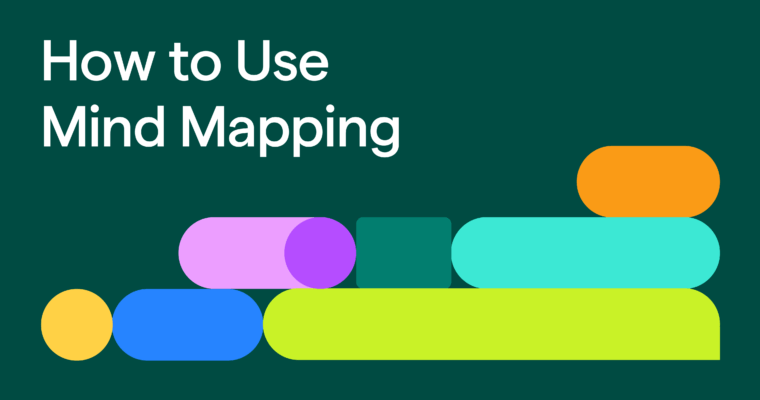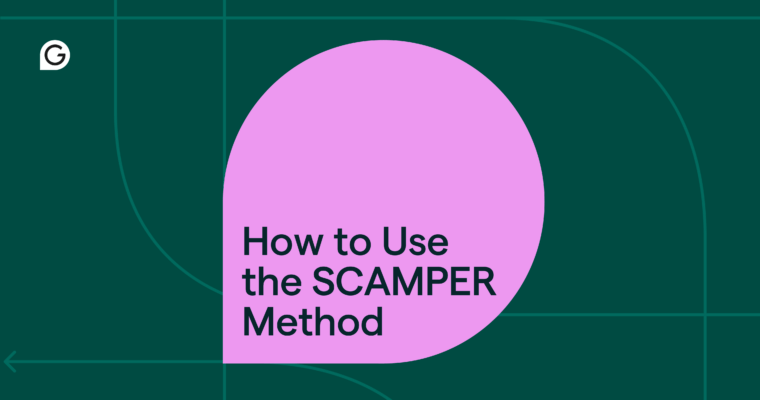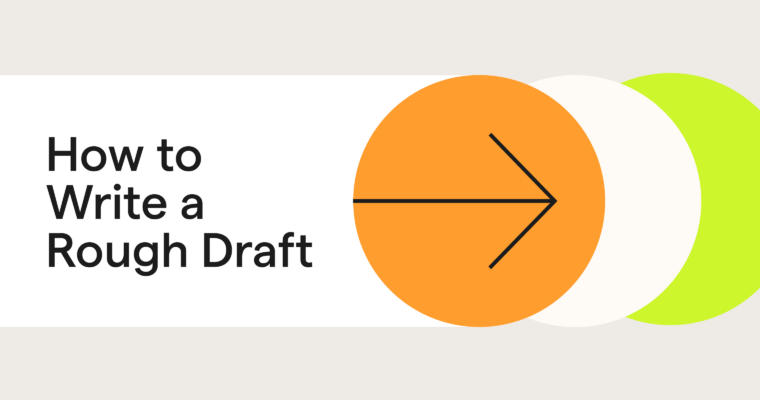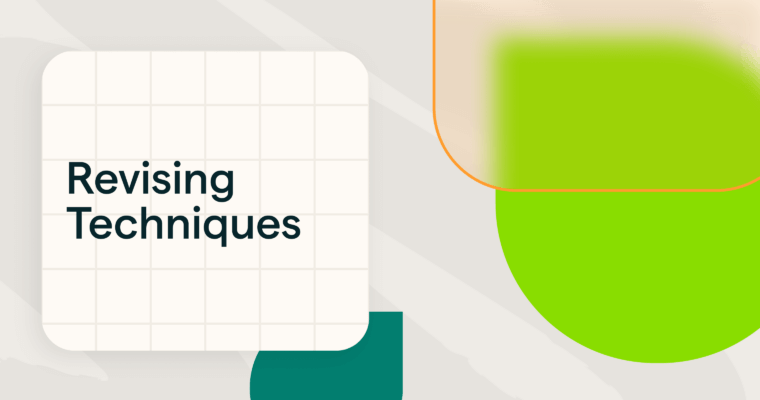
Key takeaways
- Mind mapping is a way to visually organize ideas around a central topic so you can see connections and gaps at a glance.
- It works best when you use single keywords, branch gradually, and show relationships across branches.
- Students and professionals use mind maps to brainstorm, study, plan, and problem solve during the prewriting phase, then turn mind maps into outlines and drafts.
- With an organized structure and a flexible format, mind maps make it easier to turn complex ideas into clear, actionable plans.
If you’ve ever stared at a blank screen, unsure where to begin writing, or tried to wrangle a mess of ideas into something cohesive, mind mapping might be the solution you need. This visual thinking technique helps you capture ideas quickly, spot connections, and organize information before you start writing.
Mind mapping is effective because it mirrors how your brain works: associatively, not linearly. Whether you’re outlining an essay, managing a project, or planning a presentation, it helps you turn scattered thoughts into structured clarity.
This guide explains what mind mapping is, why it works, and how to use it effectively, with examples, practical tips, and a look at how Grammarly can help you take your map from brainstorm to polished draft.
Table of contents
- What is mind mapping?
- What are the benefits of mind mapping?
- When to use mind mapping, with examples
- How to create a mind map in 7 steps
- Mind mapping tips and techniques
- Common mistakes to avoid when mind mapping
- What do I do next with my mind map?
- How Grammarly can help turn your mind map into a draft
- Mind mapping FAQs
What is mind mapping?
Mind mapping is a strategy for visually organizing information. A mind map is a graph that shows how ideas relate to a central topic using branches and concise keywords. Popularized by Tony Buzan, it works by placing a central idea in the middle, then branching outward into main themes and subpoints while connecting related concepts.
As a brainstorming technique for writers, mind mapping helps you explore ideas freely before outlining. It’s especially useful in the early stages of the writing process when you need to capture and connect ideas without worrying about structure. It can also help you craft an outline by creating a logical flow of points to follow in your work.
What are the benefits of mind mapping?
Mind mapping isn’t just for note-taking; it’s a tool for exploring concepts creatively, improving your memory, and clarifying complex information. Take a look at the following seven benefits of mind mapping.
Improved creativity
Mind mapping encourages divergent thinking, helping you explore multiple directions from one idea. Divergent thinking is a key ingredient for creativity.
Here’s a quick example:
A content creator planning a post on the subject of remote work might branch that concept into themes like focus, communication, and time management. By doing this, they can explore ideas more comprehensively, potentially finding overlaps between branches or ways to go further with certain ideas than they have before.
Enhanced memory and recall
Mind maps mirror how the brain stores information—through associations, visuals, and spatial layout. A student studying anatomy might map a body system, adding color and images to represent each organ. These visual cues strengthen recall and make studying more engaging.
Boosted productivity and focus
Because it’s visual, a mind map shows relationships between tasks or topics at a glance. A project manager could map phases, deliverables, and responsibilities to instantly see dependencies. Instead of feeling buried under a list, you’ll see your priorities clearly.
Help with problem-solving
When you map a complex problem, you can spot patterns and root causes. A product team might cluster user complaints into themes, such as performance, usability, communication, and then use those clusters to guide updates. Mind maps help you move from confusion to clarity.
Organization for complex or nonlinear ideas
Not all ideas follow a logical order. Writers and researchers often use mind maps to organize overlapping concepts in a novel, such as characters, subplots, and themes. Because their branches can grow in multiple directions, mind maps are better equipped to record nonlinear thinking than outlines.
A way to engage and collaborate
In group settings, mind maps make brainstorming more interactive. Participants can add branches in real time and see how their input connects to others’ ideas. The result is a more dynamic, shared sense of progress.
Adaptable to any field or workflow
Mind mapping is useful across all fields and workflows. Whatever you’re working on, from academics to UX design, it helps connect ideas and find solutions. For instance, an entrepreneur can map out a business plan with branches for customers, funding, and operations, then break each into actionable goals. This versatility makes mind mapping a universal creative tool.
When to use mind mapping, with examples
Mind mapping is a versatile technique that can be used to achieve many goals, from studying and writing to planning and decision-making. Take a look at these examples of ways to use mind mapping.
Academic mind mapping
Mind mapping helps students organize ideas, understand difficult material, and plan writing assignments.
- Essay planning. Mind mapping an essay can help you find the best structure for it. Begin with a thesis in the center, then expand with arguments, evidence, and counterpoints.
- Summarizing readings. When you need to summarize a reading, mind mapping can be an easy way to show how plot points and literary devices used within them connect. Break down chapters into key themes and examples, using branches to highlight relevant details.
- Studying for exams. Create maps of historical events, scientific systems, or vocabulary to improve recall. By looking at a completed mind map, you can see the connections between events, steps, or related terms.
Professional mind mapping
In the workplace, mind mapping can simplify planning and collaboration. This is true in any field.
- Project planning. Start with your project goal in the center, then map milestones, tasks, and deadlines. If multiple people are working on the project, creating a collaborative mind map can help you work smarter and ensure no ideas are overlooked.
- Team brainstorming. Build a shared digital map where everyone adds ideas during a meeting. Once a plan is in place, mind maps are an excellent way to build momentum and identify key milestones, concerns, and possible outcomes.
- Marketing campaigns. Visualize messaging, audiences, and distribution channels to align cross-functional teams. In marketing, a mind map is a great way to connect creatives, like the copywriter and video creator, so they can build on each other’s work.
Professionals use mind maps to structure big ideas, identify dependencies, and stay aligned on outcomes.
Personal mind mapping
You can use mind maps in your own daily life to set goals, plan events, or reflect. Here are a few ideas you can use in your personal mind mapping:
- Goal setting. Map your yearly goals and branch into career, health, and relationships. You might choose to work a timeline into your map, identifying which goals support other goals.
- Journaling. Visualize emotions or values to gain perspective during transitions. This can be helpful as you grapple with a challenging topic.
- Planning trips. Map destinations, budgets, and packing lists in one view. A mind map for a trip can make it easy to get the most out of each destination, identifying the places you want to go, where you’ll stay, and experiences you plan to have.
How to create a mind map in 7 steps
Creating a mind map is simple and flexible. You can use paper, whiteboards, or digital tools. The medium doesn’t matter nearly as much as the ideas and effort. Follow these seven steps to create an effective mind map.
1. Start with a central idea
Write your main topic in the middle of the page. This could be your goal, your paper’s thesis statement or title, or simply the idea you’re exploring, such as causes of climate change. Starting with a clear idea makes it easier to identify the right branches to explore.
2. Add main branches
Write three to five main categories around the center, then circle them and draw lines connecting them to your main idea. For example, if your subject is “causes of climate change,” your branches might be “human activities,” “natural factors,” “environmental impact,” “solutions,” and “research sources.” These are your main branches.
3. Use single keywords
Branching off the first set of concepts, write out related concepts. Label each node with one concise word or phrase. For instance, write “deforestation” instead of “the cutting down of trees across rainforests.” Keywords keep your map scannable and flexible.
4. Expand with sub-branches
Add supporting ideas beneath each branch. Under “human activities,” you might include fossil fuels, agriculture, and industrial waste. Sub-branches deepen your thinking without cluttering the map, supporting each branch. If you’re mind mapping an essay, these may become the topics you discuss to support your points.
5. Use color, images, or symbols
Colors and visuals make information memorable. You might use green for environmental factors, red for human causes, and blue for potential solutions. Visuals boost engagement and recall. Be as creative as you’d like! The goal here is to make the information stick in your mind, so if colors and symbols help, use them.
6. Show relationships
Use lines or arrows to connect related branches. For example, link “carbon emissions” under “human activities” to “rising temperatures” under “environmental impact” to show cause and effect. These links reveal patterns you might otherwise miss.
7. Emphasize key points
Use bold text or symbols to highlight priorities, like stars for key sources or bold text for your main arguments. Emphasis makes the map easier to review later.
Mind mapping tips and techniques
- Start messy and refine later. Capture ideas freely before tidying up the layout.
- Use one keyword per node. This keeps your thinking sharp and your layout readable.
- Color-code branches. Use distinct colors for themes to improve visual grouping.
- Try both paper and digital tools. Paper can spark creativity; digital maps are ideal for collaboration.
- Leave space for revisions. Expect new ideas to arise. Mind maps should evolve as you create and revisit them.
- Group and connect ideas visually. Draw lines or arrows to show interdependence.
- Keep the layout organic, not rigid. Let your map grow naturally; symmetry can limit creativity.
Common mistakes to avoid when mind mapping
Writing long sentences instead of keywords
Mind maps work best when branches are short and clear. Use “causes of pollution” instead of a full sentence like “This is where I’ll talk about the causes of pollution.” Remember, mind maps are part of prewriting, so you’ll flesh out your ideas in the first draft.
Overcomplicating with too many branches
Start simple. Jumping into 10 branches too soon can make your map chaotic. Begin with a few major themes and expand gradually. One way to do this is to stick to two nodes on each branch. For example, you might identify two branches off your main idea, then two branches off each of those for a total of four sub-branches, and so on.
Not connecting related ideas
Draw visible connections between ideas. Without them, relationships, like the connection between “target audience” and “messaging,” can get lost. A mind map should be extremely easy to follow, so make connections as clear and obvious as possible.
Using rigid layouts
Perfect symmetry can prevent growth. Leave room for new insights as you develop ideas. If you’re creating your mind map on paper, literally use the whole page instead of squishing the map into a small portion of it.
Ignoring color or visuals
A monochrome map is harder to follow and remember. Use color or symbols to distinguish categories.
Leaving the mind map static
Your first version isn’t final. Revisit your map as you refine your thinking. If the original becomes too complicated to follow, create a second version that reflects the revisions you made to the first.
What do I do next with my mind map?
Once your map feels complete, it’s time to turn it into a more actionable document, like an outline. Follow these steps to transform your mind map into a helpful outline:
- Write a clear goal. Define your purpose (e.g., “Explain how climate change affects coastal cities”).
- Keep only relevant branches. Trim anything that doesn’t serve your goal.
- Turn main branches into sections. Each becomes a section of the outline. Generally, sub-branches become supporting points for main branches.
- Add structure and transitions. Decide the best sequence and flow for your paper and include them in your outline.
- Build your outline. Expand branches into sentences to create your outline, which serves as a guide for your first draft. Think of it like your draft’s skeleton. The content you write in the first draft is its soft tissue and organs.
How Grammarly can help turn your mind map into a draft
Grammarly’s AI tools help you smoothly transition from brainstorming to writing. While mind mapping organizes your thoughts visually, Grammarly helps you transform them into structured, polished prose.
- Grammarly’s AI writing tools can support the transition from mind mapping to structured writing.
- Get in-depth feedback with Expert Review to ensure your structure and logic meet the standards of your discipline.
- Preview audience reactions with Reader Reactions to make sure you’re communicating exactly what you intend.
Mind mapping FAQs
What is the purpose of mind mapping?
Mind mapping helps you organize and connect ideas visually, making brainstorming and planning more effective.
Is mind mapping better than outlining?
They work best when done together: mind mapping for generating ideas, outlining for structuring them.
Can you use mind mapping for studying?
Yes. Mind maps make complex topics easier to understand and recall through visual connections.
What are the three things every mind map needs?
A clear central idea, connected branches, and concise keywords that summarize each point.
How do you turn a mind map into a draft?
With a finished mind map, write out the main branches as section headers. Arrange them in an order that provides a logical flow to support the draft’s thesis statement. Then write each sub-branch beneath its respective main branch. These will become the content you include in each section.






